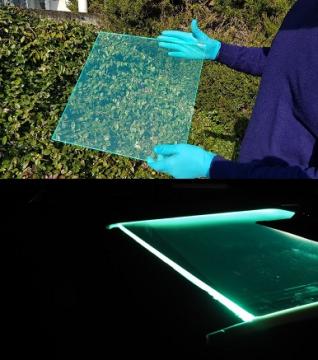
A further and fundamental step towards the construction of zero-impact buildings through the construction of photovoltaic devices that can be aesthetically integrated into buildings (building integrated photovoltaics) is made possible thanks to the research carried out by a team of Italian researchers of the University of Milano - Bicocca, the Company Glass to Power SpA and the CNR Institute of Structure of Matter. An innovative material for the realization of transparent luminescent solar concentrators (LSC) integrated into photovoltaic windows with high efficiency has been synthesized in the laboratories of the Department of Materials Science of the University of Milan-Bicocca through an innovative, solventless process with low environmental impact. This strategy has the important advantage of reducing the weight ratio between waste and product (a metric known as the E-factor), one of the most common sustainability index in organic synthesis. In the specific case, the E Factor demonstrated is 50 times lower than that associated with other molecules of comparable efficiency. The innovative materials thus created were then used by the researchers of Glass to Power to manufacture photovoltaic windows with industrial techniques, confirming the applicative potential of the discovery.
The results of this research have been published in the prestigious Joule journal (Impact factor 27.054 - 2019 Journal Impact Factor, Journal Citation Reports (Clarivate Analytics, 2019)) in the article entitled “Chemically Sustainable Large Stokes Shift Derivatives for High-Performance Large- Area Transparent Luminescent Solar Concentrators ”(doi: 10.1016 / j.joule.2020.08.006).
This research has seen the contribution of a large team of professors, researchers, postdocs and PhD students from the Department of Materials Science belonging to three different research areas: organic synthesis (Prof. Luca Beverina, Dr. Mauro Sassi), electrochemistry (Prof. Riccardo Ruffo), and advanced photophysics (Prof. Sergio Brovelli, Prof. Franco Meinardi, Prof. Angelo Monguzzi).
What are the advantages of photovoltaic windows based on luminescent solar concentrators compared to conventional systems?
Photovoltaic windows based on luminescent solar concentrators are very simple, have a low construction cost and a conversion efficiency less sensitive to non-optimal positioning with respect to insolation. Another fundamental advantage is that they do not distort the aesthetics of the buildings. The operation principle of luminescent solar concentrators is based on the intrinsic property of many classes of organic molecules to absorb solar radiation over a broad spectrum of wavelengths and to re-emit it at a well-defined wavelength - larger and not superimposable with the interval of absorption - and with high emission efficiency. Molecules possessing such characteristics, alongside with high thermal and photostability are dispersed within a Plexiglas plate during its manufacturing process. The solar radiation is thus absorbed and then re-emitted by the molecules, and the Plexiglas plate provides the cheapest "wave guide" to trap the radiation and convey it to the edges. Sheets of this type are mounted in normal window frames where thin and invisible photovoltaic cells convert the concentrated light radiation into electric power.
How is it possible to the synthesize the new molecules without solvents?
The molecule is designed starting from rational principles of chemical synthesis in order to require a simple, rapid, efficient and low environmental impact synthesis thanks to the removal of process solvents - explains Luca Beverina. - The key steps of the required transformations are in fact carried out with mechanochemical techniques: the reagents are dry mixed in a vibratory mixer (industrially known as a ball mill) which guarantees high yields at low contact times even in the absence of solvent. The E-Factor, has been demonstrated to be 50 times lower than that associated with other molecules of comparable efficiency prepared using organic solvents.